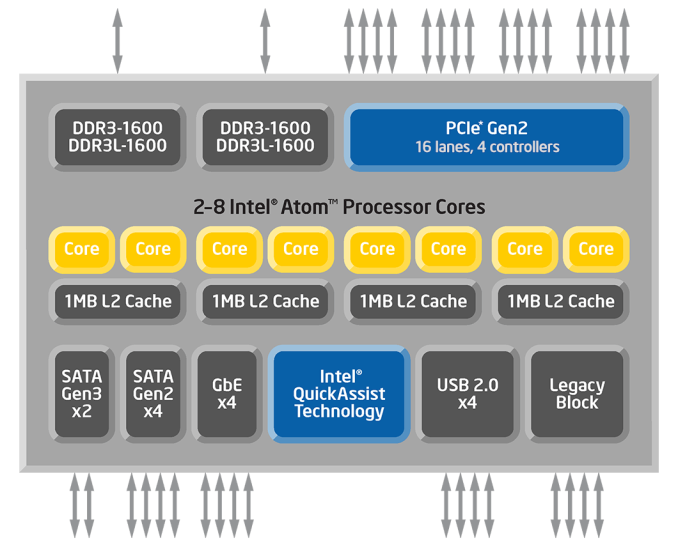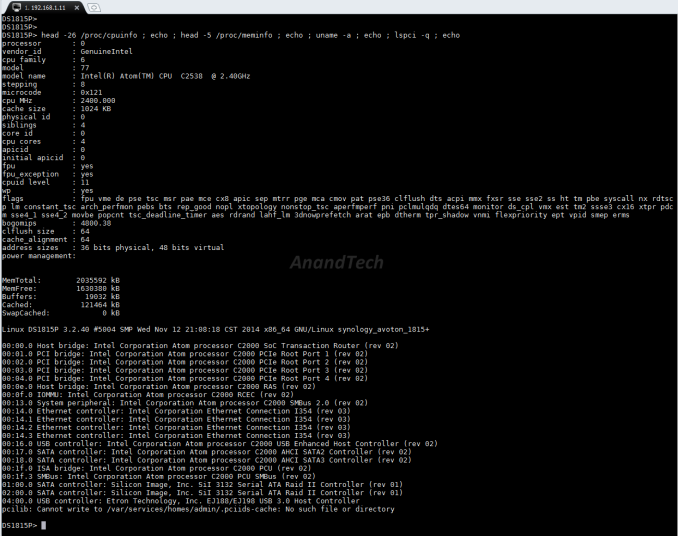Synology DS1815+ 8-bay Intel Rangeley SMB NAS Review
by Ganesh T S on November 18, 2014 6:30 AM ESTPlatform Analysis
The higher end segment of the SOHO / SMB NAS market uses Intel's Core-series and Xeon CPUs to deliver the required performance while supporting a large number of drive bays (typically more than 8, in a rackmount form-factor). Over the last four years or so, Intel's play in the other tiers has been mainly with its Atom CPU lineup. Back in 2010, Intel pushed the 45 nm Atom D410 / D510 / D525 for NAS units. In 2012, it was the 32 nm Atoms, the D2550 and D2700. All of these were based on the in-order Bonnell microarchitecture which was fast becoming dated compared to the advancements being made by the ARM SoC vendors. In moving from 32nm to 22nm, Intel completely revamped the microarchitecture for their Atom cores. Bonnell was replaced by Silvermont, bringing out of order execution and other improvements into the picture. Silvermont's applicability to a variety of power profiles meant that there were multiple product lines that ended up using the CPU cores. Bay Trail is proving very effective in tablets and also makes up QNAP's TS-x51 and TS-x53 Pro NAS series. Merrifield and Moorefield are trying to break into smartphones, but it is Avoton and Rangeley that are more relevant to the storage appliances market.
The different product lines integrate different I/O around the Silvermont cores depending on the target market. Avoton is meant for microservers and cloud storage platforms, while Rangeley is meant for communication and network infrastructure. Both of them integrate similar I/O around the cores, but the Rangeley parts have an updated crypto engine. The block diagram of a generic Rangeley part is provided below.
There is a wealth of I/O (2x SATA Gen 3, 4x SATA Gen 2 and up to 16 PCIe 2.0 lanes) for the storage subsystem, and the parts also support up to 4x 2.5 Gbps network links. From the viewpoint of the Synology DS1815+, the above block diagram should be considered in the context of the information gleaned via SSH access to the unit.
The DS1815+ uses the Intel Atom C2538 SoC which has four Silvermont cores running at 2.4 GHz. It is backed up by 2 GB of DRAM. The Atom C2538 has 16 PCIe 2.0 lanes. The Silicon Image SiI3132 PCIe to 2-port SATA II host controller uses a single PCIe 2.0 lane on the host side. There are two of them using up two PCIe 2.0 lanes in total. Unlike the DS415+ in which the USB 3.0 ports were provided by the Etron EJ168 USB 3.0 host controller, the DS1815+ uses the Etron EJ198. This USB 3.0 host controller uses two PCIe lanes to enable the four USB 3.0 ports found on the rear side of the unit. The four Ethernet controllers are all based on the Intel I354. Despite being 2.5G-capable, the transceivers they are connected to make them GbE ports.
The more interesting hardware aspect is the absence of any PCIe to SATA bridges for the internal ports. Given that the C2538 has only a total of six SATA ports (2x SATA III and 4x SATA II) and there are no bridges in the SSH report, it can be inferred that a port multipler (1x SATA host to 2x SATA device) such as the ASMedia ASM1092 must be in use. However, without opening up the unit (which we haven't done yet, given our limited time to bring out the review), this can't be confirmed.
On the software front, the DS1815+ runs Linux (kernel version 3.2.40). We have covered DSM 5.0's setup and usage impressions in our recent DS214play and DS414j reviews. There is not much point in rehashing the same excellent setup and usage experience. That said, with the ioSafe 1513+, we also started looking at iSCSI support in NAS units. We will be looking at that aspect in this review also.












65 Comments
View All Comments
DigitalFreak - Wednesday, November 19, 2014 - link
Not everyone is poor like you.chaos215bar2 - Wednesday, November 19, 2014 - link
I see a lot of comments like this, and I can only imagine you're assuming that:1) The NAS is only being used as a file server with the most basic setup.
2) Updates are not an issue.
I agree that building a custom NAS box is a fun project and can save a lot of money. However, not everyone wants to deal with the complications that can arise from setting up multiple services and keeping them up-to-date.
Say you want an email server. To install and fully configure Synology's Mail Station takes no more than 10 minutes. If you want webmail to go with it, just install a second package. There's almost zero setup required. Sure, you'll have more options on a generic Linux installation, but setting up a fully functional and securely configured email system takes quite a lot of research if you're just doing it one time.
Of course, all of that time spent properly configuring your custom-built server is worthless if you don't keep it up to date. As of DSM 5.1, Synology will automatically install either all updates or just security updates, and you know that the updated components have been tested and work together. I have never had a problem with a service going down due to a Synology update. With full Linux distributions, not so much. Most of the time updates work fine, but I would never trust something as critical as my primary email server to automatic updates.
shodanshok - Friday, November 21, 2014 - link
Hi,while I agree on the simplicity argument (installing postfix, dovecon and roundcube surely require some time), RedHat and CentOS distros are very good from an update standpoint. I had very little problems with many server (100+) administered over the past years, even with automatic update enabled. Moreover, with the right yum plugin you can install security updates only, if you want.
Nowadays, and with a strong backup strategy, I feel confident enough to enable yum auto-update on all server except the ones used as hypervisors (I had a single hypervisor with auto-update enabled for testing purpose, and anyway it run without a problem).
Sadly, with Debian and Ubuntu LTS distros I had some more problems regarding updates, but perhaps it is only a unfortunately coincidence...
Regards,
shodanshok - Tuesday, November 18, 2014 - link
Hi agree with people saying that similar units are primarily targeted at users that want a clean and simple "off-the-shell" experience. With units as the one reviewed, you basically need to insert the disks, power on the device and follow one or two wizards.That said, a custom-build NAS has vastly better performance/price ratio. One of our customer bought a PowerEdge R515 (6 core Piledriver @ 3.1+ GHz) with 16 GB of ECC RAM, a PERC H700 RAID card with 512 MB of NVRAM cache memory and a 3 years on-site warranty. Total price: about 1600 euros (+ VAT).
He then installed 8x 2TB WD RE and I configured it with a 11+ TB RAID6 volumes with thin LVM volumes and XFS filesystem. It serves both as a backup server (deduplicated via hard links and rsync) and as a big storage for non-critical things (eg: personal files).
Our customer is VERY satisfied of how it works, but hey - face the reality: a skilled people did all the setup work for him, and (obviously) he paid us...
Beany2013 - Thursday, November 27, 2014 - link
This is about the most sensible comment on this entire review.If his budget halved and he couldn't necessarily afford support from you on a regular basis (or at least wanted his hourly callout charge to be lowered) I'm guessing you'd be more tempted to push him in the direction of a device like this, though?
(I've been there, done that, and swapped out more than a few Windows SBS/standard+exchange boxes for Syno units over the last few years for this very reason, natch - the Windows license costs themselves pretty much pay for one of these)
eximius - Thursday, December 11, 2014 - link
I have to agree with these previous two comments.I have an 1813+ sitting next to my heavily modded (aka needed to use a dremel) case with 15 hot swap disks (currently Linux + btrfs + samba & NFS). I have and use (and love) both. There are use cases for both, but I would certainly not hand my custom solution over to someone random and expect it to just work. I have automated updates and reboots (all hail "if [ -f /var/run/reboot-required ]") but occasionally something does not work right. No normal person is going to be able to figure that out in a reasonable amount of time.
Also 30 minutes to install and configure it yourself is total BS. I have saltstack and automated PXE installs at home and 30 minutes is still stretching it for me for a full stack install and configure. Linux + Samba + backup + updates + RAID and/or mdadm and/or zfs and/or btrfs installed and *configured* in 30 minutes is beyond optimistic, even for technical people. $800 does not cover 8 hours of my time, so ya, I recommend Synology for certain (mostly home/SOHO) scenarios.
I can expect my 70 year old dad to be able to keep his synology up to date, but not a Linux or BSD distro. That is just a ridiculous thing to expect.
DustinT - Tuesday, November 18, 2014 - link
Ganesh, thanks for the thoughtful review. I am very interested in seeing how SSD caching affects performance. Take 2 drives out, replace them with 240gb SSDs and retest. Synology is putting a lot of emphasis on ssd caching, and I will be making my buying decision largely based on that aspect alone.eximius - Thursday, December 11, 2014 - link
It depends on your use case. For large sequential transfers SSDs are not going to help you very much since a couple of spinning metal drives can easily saturate a gigabit link. If you need a lot more IOPS then an SSD cache will help you out here but only so much, since again the limit is gigabit ethernet (16000 IOPS or so).*note* this applies to gigabit links, 10+ gigabit ethernet or infiniband connected devices can see an improvement with SSDs.
mervincm - Tuesday, November 18, 2014 - link
Yes, please , test Read and Write Cache effect. In my 1813+ (4GB) on DSM 5.0 I installed a 2 disk Read/Write SSD Cache. Strangely streaming performance dropped, and since my use case is highly dependent on streaming, I removed the cache. I wonder now if things are better with 5.1 or with the read only cache.eximius - Thursday, December 11, 2014 - link
First, your bottleneck is the gigabit LAN. A couple of spinning rust drives can easily saturate a gigabit link so an SSD cache is not going to accelerate a streaming (aka sequential read) operation over gigabit ethernet. If you need more IOPS then an SSD cache will help (gigabit ethernet tops out somewhere around 16000 IOPS), though at the cost of reduced throughput.IOPS and throughput are at opposite ends of the spectrum, an increase in one means a decrease in the other. If your use case is sequential reads and writes, don't bother with the SSDs. On DAS (direct attached storage) you can improve both IOPS and throughput with an SSD cache since it takes a whole lot of platters to equal the performance of a single 850 pro SSD.
Also note that this problem has nothing to do with Synology, you have the same constraints even if you had 24+ thread CPU(s) and 128 GB+ RAM with <insert favourite redundancy technology here>. Gigabit ethernet is slow, period.